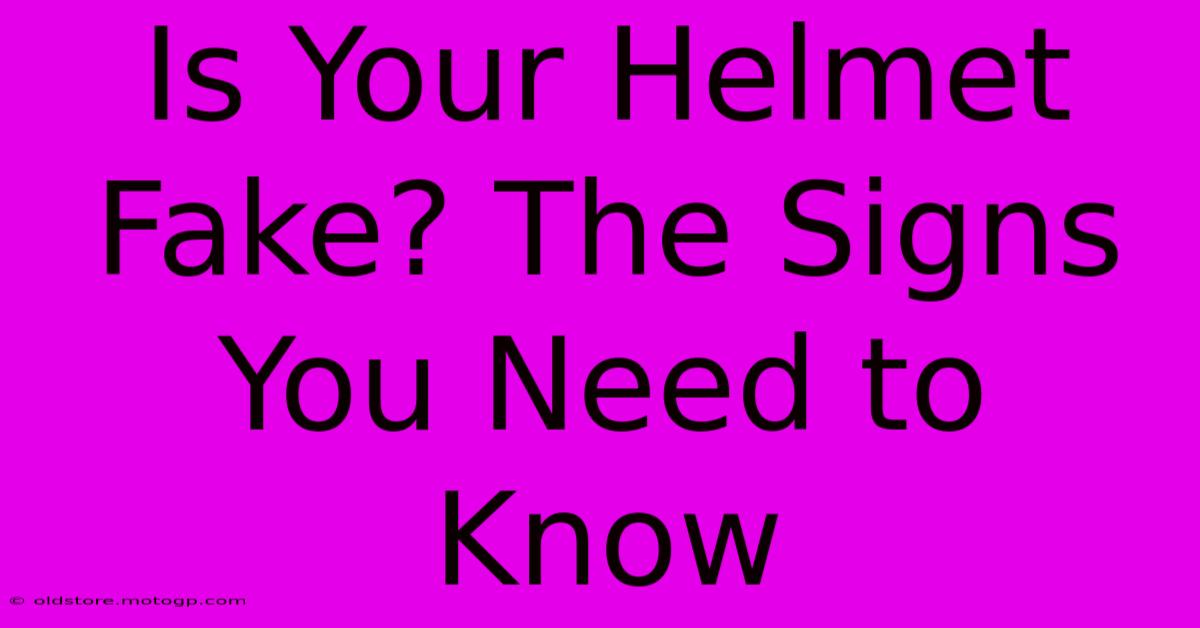Is Your Helmet Fake? The Signs You Need To Know

Table of Contents
Is Your Helmet Fake? The Signs You Need to Know
Protecting your head is paramount, especially when engaging in activities like cycling, motorcycling, skateboarding, or skiing. Your helmet is your first line of defense against serious injury, so ensuring it's authentic and meets safety standards is crucial. But how can you tell if your helmet is a counterfeit? Knowing the signs is vital for your safety.
Why Fake Helmets Are Dangerous
Fake helmets are often made with inferior materials and lack the rigorous testing and certification of genuine helmets. This means they offer significantly less protection in a crash, potentially leading to:
- Increased risk of head injuries: A fake helmet might shatter, crack, or deform improperly upon impact, failing to absorb the force and leaving you vulnerable to serious brain trauma, skull fractures, and other life-altering injuries.
- Reduced impact absorption: Genuine helmets are designed to absorb impact energy, reducing the force transferred to your head. Counterfeits often lack this crucial feature, leaving you with a higher risk of injury.
- Compromised structural integrity: Fake helmets may have weak stitching, poor shell construction, or inadequate liner materials. This compromises the overall structural integrity, making them unreliable in a fall or collision.
- Lack of safety certification: Reputable helmets undergo stringent testing and certification (like DOT, ECE, Snell, or CPSC) to ensure they meet safety standards. Counterfeits often lack these certifications or display fake ones.
Spotting a Fake Helmet: Key Indicators
Identifying a counterfeit helmet requires careful observation. Here are some crucial signs to watch out for:
1. Price:
- Unbelievably low prices: If a helmet's price is significantly lower than comparable models from reputable brands, it's a major red flag. Be wary of "too good to be true" deals. Legitimate brands rarely offer deep discounts on safety equipment.
2. Packaging and Labeling:
- Poor quality packaging: Look for inconsistencies like blurry printing, misspellings, or low-quality materials on the box. Genuine helmets usually come in professional-looking packaging.
- Missing or incorrect certifications: Check for the appropriate safety certifications (DOT, ECE, Snell, CPSC, etc.) clearly marked on the helmet and its packaging. If the markings look suspicious or are missing altogether, proceed with caution. Verify these certifications on the manufacturer's website.
- Inconsistent branding: Look for inconsistencies in logos, font styles, and overall branding compared to the manufacturer's official website.
3. Helmet Construction:
- Poor craftsmanship: Examine the helmet's shell for imperfections like uneven surfaces, rough edges, or inconsistent paint jobs. Genuine helmets usually exhibit a high level of craftsmanship.
- Cheap materials: Feel the materials. Counterfeit helmets often use cheap, flimsy plastics or foams. Genuine helmets generally feel more substantial and well-constructed.
- Weak straps and buckles: Check the chin strap for durability and proper stitching. Flimsy straps or poorly functioning buckles are significant warning signs.
- Unclear or faded markings: Genuine helmets often have clear and durable markings indicating the size, model, and manufacturer. Faded or unclear markings can suggest a counterfeit.
4. Where You Buy It:
- Unverified online retailers: Avoid purchasing helmets from unfamiliar or unverified online retailers, especially those with suspiciously low prices.
- Unlicensed vendors: Purchase your helmet from authorized dealers or reputable retailers known for selling genuine products.
What to Do if You Suspect a Fake
If you suspect your helmet is a fake, do not use it. Your safety is non-negotiable. Replace it immediately with a helmet purchased from a reputable source and verified as authentic.
Protecting Yourself: Buying a Genuine Helmet
- Buy from authorized retailers: Purchase your helmet from authorized dealers or reputable online stores to ensure authenticity.
- Verify certifications: Always check for the appropriate safety certifications.
- Research the brand: Familiarize yourself with the manufacturer's website and learn about their authentication methods.
- Read reviews: Check online reviews from other buyers to gauge the quality and authenticity of the product and retailer.
Your helmet is your life insurance. Don't compromise your safety with a fake. Invest in a genuine, properly certified helmet from a trusted source. Your well-being depends on it.

Thank you for visiting our website wich cover about Is Your Helmet Fake? The Signs You Need To Know. We hope the information provided has been useful to you. Feel free to contact us if you have any questions or need further assistance. See you next time and dont miss to bookmark.
Featured Posts
-
Airport Travel Reimagined The F1 Shuttle
Feb 19, 2025
-
The Art Of Air Mastering Moto Gp Aerodynamics
Feb 19, 2025
-
Ex Factory Race Bikes Ride The Future
Feb 19, 2025
-
Austin Gp 2025 A Celebration Of Motorsport
Feb 19, 2025
-
Moto Gp Accident The Importance Of Rider Experience
Feb 19, 2025
